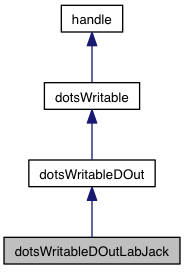Overview
Implement digital outputs using the LabJack device and its libraries.
Created 6/10/19 by jig from example code sent by Ryan Archer

Properties and Events | |
| Property | pulsePort = 0 |
| Using labjack class properties. | |
| Property | pulsewidth = 10 |
| TTL pulse width. | |
| Property | verboseMode = false |
| milliseconds More... | |
 Properties and Events inherited from dotsWritableDOut Properties and Events inherited from dotsWritableDOut | |
| Property | defaultPauseBetweenPulses = 0.1 |
| for sendTTL pulses | |
 Properties and Events inherited from dotsWritable Properties and Events inherited from dotsWritable | |
| Property | isAvailable = false |
| |
| Property | clockFunction |
| |
Protected Properties | |
| Property | daq |
| The labJack object. | |
Methods | |
| self | dotsWritableDOutLabJack (varargin) |
| Arguments are ultimately passed to openDevice. | |
| timestamp | sendTTLPulse (self, pulsePort) |
| Send a TTL pulse. More... | |
 Methods inherited from dotsWritableDOut Methods inherited from dotsWritableDOut | |
| self | dotsWritableDOut () |
| Constructor takes no arguments. | |
| timestamp | sendStrobedWord (self, word, port) |
| Send a strobed digital word. More... | |
| timestamp | sendTTLPulse (self) |
| Send a single TTL pulse. More... | |
| firstTimestamp lastTimestamp | sendTTLPulses (self, numPulses, pauseBetweenPulses, channel) |
| Send multiple TTL pulses Timestamps are estimates of onset times of first and last pulses. More... | |
| timestamp | sendTTLSignal (self, channel, signal, frequency) |
| Send a TTL signal or waveform. More... | |
 Methods inherited from dotsWritable Methods inherited from dotsWritable | |
| self | dotsWritable () |
| |
| initialize (self, varargin) | |
| |
| time | getDeviceTime (self) |
| |
| close (self) | |
| |
| delete (self) | |
| |
Additional Inherited Members | |
 Protected Methods inherited from dotsWritable Protected Methods inherited from dotsWritable | |
| openDevice (self) | |
More... | |
| closeDevice (self) | |
More... | |
 Static Methods inherited from dotsWritableDOut Static Methods inherited from dotsWritableDOut | |
| static dout | getDefault () |
| get default Dout device | |
Methods
◆ sendTTLPulse()
| timestamp sendTTLPulse | ( | self | , |
| pulsePort | |||
| ) |
Send a TTL pulse.
Returns the timestamp returned from sendTTLSignal(). As long as pulseSignal begins with a true value, the timestamp will be an estimate of when channel transitioned to a high value. See sendTTLSignal() for timing details and other details.
Properties and Events
◆ verboseMode
| Property verboseMode = false |
milliseconds
For debugging
The documentation for this class was generated from the following file:
- dotsWritableDOutLabJack.m
 1.8.15
1.8.15